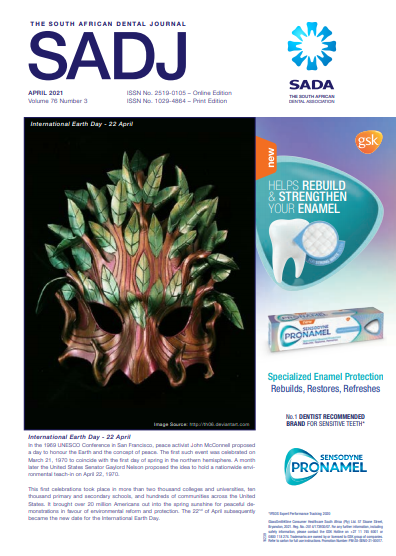Oral hygiene habits and status of orthodontic patients attending the University of Pretoria, Oral and Dental Hospital
DOI:
https://doi.org/10.17159/2519-0105/2021/v76no3a2Keywords:
oral hygiene habits, orthodontic patientsAbstract
Most orthodontic patients struggle to maintain good oral hygiene during treatment. To determine oral hygiene habits and status of patients undergoing fixed orthodontic treatment at University of Pretoria, Oral and Dental Hospital. A cross-sectional descriptive study. A modified, validated, self-administered questionnaire was used, and clinical examinations were conducted using Orthodontic Plaque Index, Gingival index, and Bleeding index. The questionnaire sought to determine knowledge and practice patterns. Data analysis included frequencies and correlations using chi-square test, with a significance of p<0.05.
Fifty patients participated with 34(68%) being female with ages from 10 to 28 and a mean of 18,5. Seventy percent avoided sticky foodstuff, 74% used mouthwash, 56% flossed daily and 84% brushed twice daily. However, 82% consumed sugar containing drinks. Clinical exam revealed an Orthodontic Plaque Index mean
of 2.6, Gingival Index mean of 0.1 while the Bleeding Index was 13.3 and 90% had normal gingiva. There was a significant difference in Gingival Index score between patients at age category 10-19 and 18-24 (p< 0.05). This study revealed a satisfactory oral hygiene status among patients at the institution with the majority of patients maintaining good oral hygiene practices. However, 82% consumed sugar sweetened beverages.
Downloads
References
Shaw WC, O'Brien KD, Richmond S. Quality control in orthodontics: factors influencing the receipt of orthodontic treatment. Br Dent J. 1991; 170(2): 66-8.
Derks A, Kuijpeers-Jagtman AM, Frencken JE, Martin A, Hof V, Katsarose C. Caries preventative measures used in orthodontic practices: An evidence-based decision. AJO. 2007; 132(2): 165-70.
Zachrisson BU, Alnaes L. Periodontal condition in orthodontically treated and untreated individuals. I. Loss of attachment, gingival pocket depth and clinical crown height. Angle Orthod. 1973; 43(4): 402-11.
Alexander SA. Effect of orthodontic attachments on the gingival health of permanent second molars. Am J Orthod Dentofacial Orthop. 1991; 100(4): 337-40.
Duncan Y. Brown , Terry D. Carlyle, Darren Isfeld. Systematic evaluation of patient oral hygiene for orthodontic patients. AJO. 2009; 1(1): 1-8.
Øgaard B, Rølla G, Arends J. Orthodontic appliances and enamel demineralization Part 1. Lesion development. Am J Orthod Dentofacial Orthop. 1988; 94(1): 68-7134 .
Chang HS, Walsh LJ, Freer TJ. Enamel demineralization during orthodontic treatment. Aetiology and prevention. Aust Dent J. 1997; 42(5): 322-7.
Morrow D, Wood DP, Speechley M. Clinical effect of subgingival chlorhexidine irrigation on gingivitis in adolescent orthodontic patients. Am J Orthod Dentofac Orthop. 1992; 101(5): 408-13.
Kharsa MAI. The importance of oral hygiene in orthodontic treatment. The Orthodontic Cyber Journal. 2008; 1(1): 1-9.
Skidmore KJ, Brook KJ, Thomson WM, Harding WJ. Factors influencing treatment time in orthodontic patients. AJO. 2006; 129(2): 230-8.
Ajayi EO. Oral hygiene status among orthodontic patients attending, journal of dental health, oral disorders and therapy. 2014; 1(4): 1-4.
Bardal PAP, Olympio KPK, Bastos JRM, Henriques JFC, Buzalaf MAR. Education and motivation in oral health-preventing disease and promoting health in patients undergoing orthodontic treatment. Dental Press J Orthod. 2011; 16(3): 95-102.
Atassi F, Awartani F. Oral hygiene status among orthodontic patients. J Contemp Dent Pract. 2010; 11(4): 25-32.
Heintze SD, Jost-Brinkmann PG, Finke C, Miethke RR. Orthoplaque Index. In: Oral health for the orthodontic patient. Chicago: Quintessence. 1999; 67-70.
Löe H. The gingival index, the plaque index and the retention index systems. The Journal of Periodontology. 1967; 38(6): 610-6.
Newbrun E. Indices to measure gingival bleeding. Journal of periodontology. 1996; 67(6): 555-61.
Karimi-Afshar M, Torabi M, Safarian F, Dehghan MA, KarimiAfshar M. Effect of orthodontic treatments on quality of life in adolescents. Journal of Oral Health and Oral Epidemiology. 2018; 7(4): 198-204.
Abdullah AA, Yassin ZM, Zamzam N. Reasons for seeking orthodontic treatment. A Pilot Study. Annals of Dentistry University of Malaya. 2001; 8(1): 13-9.
Al Fawzan A. Reasons for seeking orthodontic treatment in Qassim region: A Pilot Study. International Dental Journal of Students Research. 2013; 1: 58-62.
Jay P, Goje SK, Narayan K, Riddhi P, Chinmay D, Aakash S. Impact of orthodontic treatment needs on Oral health-related quality of life among the early adults: a questionnaire study. Journal of International Oral Health. 2018; 8(12): 1095-100.
Kay E, Vascott D, Hocking A, Nield H, Dorr C, Barrett H. A review of approaches for dental practice teams for promoting oral health. Community Dent Oral Epidemiol. 2016; 44: 313-30.
Geiger AM, Wasserman BH, Turgeon LR. Relationship of occlusion and periodontal disease. 8. Relationship of crowding and spacing to periodontal destruction and gingival inflammation. J Periodontol. 1974; 45(1): 43-9.
Lundström F, Hamp SE, Nyman S. Systematic plaque control in children undergoing long-term orthodontic treatment. Eur J Orthod. 1979; 2(1): 27-39.
Impellizzeri A, Samà R, Roberto Di Giorgio MD, Galluccio G. Control of oral hygiene in the orthodontic patient: comparison between public facility and private practice. Annali di Stomatologia. 2018; 9(1): 43-52.
Firth F, Bennani F, Stacknik S, Farella M. Orthodontic patient co-operation: A review of the clinician's role in predicting and improving patient compliance. Australasian Orthodontic Journal. 2019; 35: 1-5.
Downloads
Published
Issue
Section
License
Copyright (c) 2021 Noluthando L Buthelezi, Thomas K Madiba

This work is licensed under a Creative Commons Attribution-NonCommercial 4.0 International License.





.png)